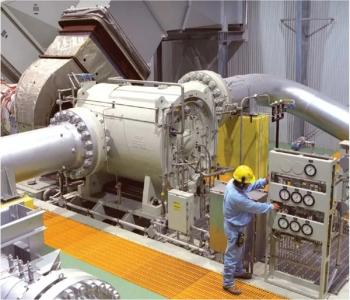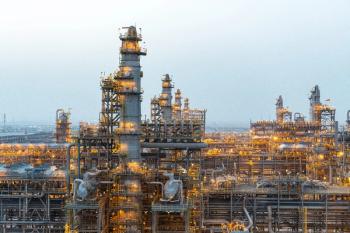
- July/August 2022
PowerGen 2022
PowerGen 2022 leaned heavily on three pillars: hydrogen generation, decarbonization, and digitalization.
PowerGen 2022 represented elements of both joy and sadness. Joy at once again seeing our friends and the many vendors that are the lifeblood of the industry. Sadness as the show feels like the former capital of a once mighty empire that has been relegated to a peripheral and decidedly provincial role.
But at least there was some fighting talk during the Monday morning keynotes. Sandwiched among those advocating a hydrogen-powered and renewable future, former U.S. Secretary of Energy Rick Perry offered a reality check. He questioned the feasibility of achieving the net-zero targets for 2050 and defended fossil fuels and nuclear power.
He campaigned for a balanced approach, saying we need all sources of generation to power the nation. He made it clear that regardless of the plans for wind, solar, batteries, and hydrogen, we are going to need fossil fuels for a long time into the future. He also called for more attention to be paid to areas such as carbon capture, utilization, and storage (CCUS) and small modular reactors (SMRs) for nuclear power.
“Does anybody think that we’re going to be able to address all of the needs of the United States by 2035, with just renewables?” said Perry. “And if the world went to net zero by 2050, it would be one of the most apocalyptic losses of life in the world’s history.”
THE FUTURE OF GAS TURBINES
A session on the future of gas turbines focused on hydrogen. Adam Foust, Gas Turbine Proposal Manager at Siemens Energy, began with a history lesson. Advances in thermal barrier coatings (TBC), aerodynamics, manufacturing techniques such as additive manufacturing (AM or 3D printing), and combustion had led to steady gains in efficiency and MW capacity. He expected the industry to continue to make progress in raising efficiency and performance.
“AM is a key part of those improvements as it has led to increased firing temperatures, greater fuel flexibility and higher efficiency,” said Foust.
3D printing has enabled component and system designs with more complex geometries, which facilitates reduced cooling flows and greater rates of heat transfer. Better mixing of fuel and air in the combustion system means higher firing temperatures as well as lowered emissions and better fuel flexibility.
“In 1985, we were at 42 ppm NOx and that also needed dilution,” said Foust. “Now, 5 ppm NOx can be achieved without dillution.”
By introducing some hydrogen into the natural gas, he added, the amount of carbon dioxide can be lowered. Siemens Energy gas turbines have been tested to operate at 30% hydrogen or more. One has run successfully with 100% hydrogen. To manage flashback risk in hydrogen combustion, Foust noted in answer to a question that there is a derate with current combustion technology. But new approaches are addressing that.
The future of gas turbines, he said, is focused on improving efficiency, increasing hydrogen fuel flexibility, and bringing more AM into GT parts and even blades, while integrating renewables and energy storage.
Ajay Gupta, Director of Product Line Management at Mitsubishi Power, also outlined his company’s pathway to 100% hydrogen generation.
“Gas turbines are vital to the future energy mix but they need greater flexibility,” he said. “the combustor is the primary technology advancement for hydrogen operation.”
Gupta also touted hydrogen as a good form of long duration storage and batteries as short duration storage. And he covered his company’s Takasago Hydrogen Park in Tokyo that is scheduled to begin operating next year. It will produce H2 onsite in electrolyzers and store it. Beginning with the H25 gas turbine, the plan is to validate operation at up to 100% hydrogen. With that achieved, larger Mitsubishi turbines can then be tested and validated.
HRSG IMPACT
Most attention on hydrogen has centered upon the impact on the combustor. But what about the heat recovery steam generator (HRSG)? Richard Saab, a Sales Manager at Siemens Energy offered insight into the main impacts of firing H2 in gas turbines on HRSGs.
For example, the combustion of hydrogen will occur at higher flame temperatures than natural gas. One of the side effects of that fact is the production of more nitrogen oxides (NOx). Secondly, the water dew point of the flue gas increases when firing hydrogen in the GT. This means that cold parts which are in contact with flue gas will form condensation quicker. Thirdly, firing H2 adds extra volume to the exhaust gas flow. Lastly, he discussed safety when firing hydrogen.
Many of these impacts are due to the characteristics of hydrogen. It has a high mass related heating value of 51,600 BTU/pound, as well as a density that is eight times lower than methane. Despite that, its benefits are attractive.
“Natural gas generation with 30% hydrogen by volume delivers an 11% reduction in CO2,” said Saab
Hydrogen’s wider explosion range and lower ignition energy compared to natural gas presents some safety concerns for HRSGs. However, he said hydrogen is expected to accumulate in the same areas of the HRSG as natural has such as the attic. Current safety procedures already take this into account and should be sufficient, but should be checked.
On the exhaust side, hydrogen requires a much higher volume of gas be passed through the turbine due to its density. Thus, the HRSG needs to be engineered to avoid exceeding the design pressure drop since increased pressure drop can cause derated performance.
As emissions of NOx will go up as more hydrogen is added, he recommended leaving space in designs for new HRSGs where an SCR could be added in the future if needed.
“Those wanting to burn hydrogen in the future should set up the HRSG for it upfront,” said Saab. “Those that do can receive a hydrogen-ready stamp that can help with financing and will minimize costs. It is far more difficult to do afterwards.”
Retrofitting an SCR into existing HRSGs would be extremely challenging. If HRSG needs a LOT of modification, it might need a new HRSG if it is older.
Other impacts: Condensation increases in the back end of the HRSG due to hydrogen. Above 50% by volume, a lot more water accumulates and this can cause more moisture in the tubes. Hydrogen can be fired in duct burners. He suggested that separate valve trains and firing elements be installed due to differences in heating value and supply pressure. “It is recommended to keep different trains of duct burners with different design for natural gas and hydrogen,” said Saab.
GREEN STEAM
With all the talk about green hydrogen, why not green steam? That was the question posed by Paul Brown, Vice President Custom Systems, Industrial Watertube Boilers at Cleaver Brooks. Hydrogen, it turns out is a viable fuel source in today’spackage watertube boilers whether they are used as auxiliary boilers in a utility power plant, a process boiler in a refinery, for cogeneration in a distributed energy center or simply as a heating boiler at the local university.
“The technology needed to facilitate hydrogen firing and eliminate CO emissions from the system is not new and does not increase risks associated with packaged boiler or burner design and operation,” said Brown
But there are design factors in both the boiler and combustion system that must be considered. The good news is that current boilers are ideally designed so they are in good shape to accommodate the burning of hydrogen.
“The flame temperature is higher with hydrogen so we must pay attention to the possibility of overheating,” said Brown. “But as all furnaces today have a 100% membrane wall construction with water-cooled surfaces and are conservatively sized, they can usually handle higher temperatures without changes.”
As far as unburned hydrogen collecting in pockets at the top of the boiler due to low molecular weight, once again there is little risk. Brown said D, O, and A style boilers leave very little space for accumulated hydrogen and thus a conventional purge cycle can eliminate the risk of hydrogen accumulation
He gave the example of a 100,000 lbs per hour boiler running at 600 PSIG and 750F. Operating on natural gas its efficiency is 84%, which drops to 79.5% on a high heating value (HHV) basis for hydrogen. At a low heating value (LHV), hydrogen has 94.1% efficiency, higher than natural gas’ 93%.
“Pay attention to LHV and HHV numbers and know which one is being referred to and design to deal with it,” said Brown.
Superheated steam from hydrogen would have a lower steam temperature (730F) compared to 750F for natural gas due to hydrogen’s lower gas side mass flow. This calls for minor design tweaks like adding more heating surface to the superheater.
A forced draft fan in an auxiliary boiler running natural gas would need to be 350 hp compared to 250 hp when fired by hydrogen. The reason a less powerful fan would be needed for hydrogen is that less combustion air is needed in combustion.”
Further pointers: hydrogen’s typically low supply pressure and low heating value requires larger fuel piping than natural gas to obtain the same BTU input to the boiler. Overall hydrogen components are likely to be larger and more expensive. To cope with higher NOx, hydrogen systems need increased flue gas recirculation (FGR) and/or SCR.
“Adding above 5% hydrogen to an existing natural gas fired boiler will push NOx over the limit,” said Brown.
Hydrogen Challenges
Day 2 of PowerGen again featured plenty of hydrogen sessions. All were standing room only. Matt Ballew, Technology Strategist for Vista, said hydrogen can either be viewed as a threat or as an opportunity. He sees plenty of opportunity for hydrogen as a baseload fuel as well as in energy storage. When wind is strong at night, turn that power into hydrogen via electrolyzers and then sell later when prices are high.
The most surprising statement was about cost. Ballew said that the most optimistic projection is a dollar a kg or 7.45 cents per mm btu, which is twice that of gas – and he’s talking about hydrogen reaching that level of cost by 2050. That means hydrogen must rely on a tax on carbon or other incentives to make progress in markets.
“The markets don’t make sense right now,” said Ballew.
Dr. Ben Emerson from Georgia Tech covered how a retrofittable combustion system is needed to make hydrogen combustion work properly and to avoid flashback – the flame propagating upstream into the nozzle and igniting.
He called into question the idea that hydrogen resulted in higher NOx. His argument centered around the use of Dry Low NOx combustors for natural gas making it difficult to do an apples-to-apples comparison as hydrogen combustion has more moisture content. He said he was discussing this with the EPA. He ended by saying that it may be possible to design a combustor for hydrogen that lowers NOx significantly.
Alan Ettlinger, Senior Director of Research Technology Development at New York Power Authority (NYPA), delivered a teaser about testing being done in conjunction with EPRI. He gave no real concrete details but said a peaker plant on Long island is being run on “more than 5% hydrogen.” I got the idea it was a lot more than 5% but he wouldn’t say. Ettlinger said we would be surprised at the findings of a study being released in the fall. He commented on some of the challenges with hydrogen. NYPA trucked in the hydrogen, which he said was a flawed approach.
“The largest hydrogen storage facility in the USA is at NASA and it would only run our plant for three days,” he said. “The hydrogen supply problem needs addressed either by large-scale electrolysis or pipelines.”
Nethra Subramanya from GE laid out GE Gas Power’s capabilities for hydrogen blends in gas turbines. She felt that it makes most sense to blend with natural gas rather than seek to operate at 100% hydrogen.
REALITY CHECK
The second day ended with a dose of reality on hydrogen. John Gulen, Bechtel Fellow for Bechtel Infrastructure and Power, began his talk by noting the hydrogen “hullabaloo.”
“I’m at PowerGen but where is the power and where are the turbines?” he said. “This is not the PowerGen I remember.”
He revealed some research findings on the optimum size and type of gas turbine to operate hydrogen. This will be covered in more detail in an article in the next issue. But it revealed that larger turbines would be far less efficient due to the amount of hydrogen that would have to be produced via electrolysis to power a combined cycle plant. The sweet spot, Gullen said, was around 200 MW.
“The smaller the GT, the better the chance of burning economically and realistically available hydrogen efficiently,” said Gullen.
He was followed by Ammar Moosa, Commercial Manager for ProEnergy, and Sairam Ellanti of WattBridge. Moosa addressed the need to design resiliency into aeroderivative turbine peaking facilities.
“Resilience is a function of time and how fast you can respond to any disruption,” he said.
Part of the problem is that no two gas or coal plants are the same. This is quite different from other industries, such as oil & gas and data centers. In these fields, repeatability is everything and that greatly improves resilience.
“Aging baseload retirements mean there is more pressure on peaking plants,” said Moosa. “Peakers are operating more than they were designed to these days.”
In addition, extreme weather conditions can cause devastation with forced outages and unmet demand. Lastly, with more wind and solar on the grid, standby peakers are needed more than ever for grid firming applications.
ProEnergy’s strategy is to bridge supply gaps by deploying its standardized LM6000 facilities for utilities and IPPs. That machine was chosen due to its fast start within 10 minutes, rapid ramp and low turndown, negligible maintenance penalty for frequent starts, and the ability to offer a low installed $/kW solution. ProEnergy announced an R&D program to assess the limits of hydrogen fuel mixes. The company will start testing below the established 30% hydrogen mix.
ProEnergy subsidiary WattBridge is supporting grid firming in ERCOT with 1,824 MW of peaking power operating or under construction in the Houston area, which is halfway to their goal of 4 GW of new power generation in Texas by 2025. Owned by WattBridge and operated by ProEnergy, these facilities require the perfect location for peakers (high-pressure, firm gas supply as well as ample transmission and water).
The H.O. Clarke Generating Station, for example, has 8 LM6000PCs. WattBridge includes various inlet conditioning including fogging to augment power output on hot days and anti-icing systems to protect operation on cold days.
During the big Texas storm of February 2021, the company’s units remained 100% available, operating continuously for 141 hours over a 6-day period – at a time when 60% of ERCOT capacity was unavailable.
Articles in this issue
about 3 years ago
TURBO TIPS: CASE STUDIESabout 3 years ago
Myth: We Can Quickly Make More LNGabout 3 years ago
VENDOR SPOTLIGHT: MITSUBISHI POWERabout 3 years ago
SUPERCRITICAL CARBON DIOXIDEabout 3 years ago
QA: SCHNEIDER ELECTRICabout 3 years ago
Turbo Tour: Power Systemsabout 3 years ago
GT MARKET TRENDSabout 3 years ago
Field Wiring EffectsNewsletter
Power your knowledge with the latest in turbine technology, engineering advances, and energy solutions—subscribe to Turbomachinery International today.





